

Duck. Ducks are sometimes confused with several types of unrelated water birds with similar forms, such as loons or divers, grebes, gallinules, and coots.
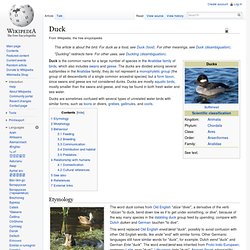
Etymology The word duck comes from Old English *dūce "diver", a derivative of the verb *dūcan "to duck, bend down low as if to get under something, or dive", because of the way many species in the dabbling duck group feed by upending; compare with Dutch duiken and German tauchen "to dive". This word replaced Old English ened/ænid "duck", possibly to avoid confusion with other Old English words, like ende "end" with similar forms. Other Germanic languages still have similar words for "duck", for example, Dutch eend "duck" and German Ente "duck". The word ened/ænid was inherited from Proto-Indo-European; compare: Latin anas "duck", Lithuanian ántis "duck", Ancient Greek nēssa/nētta (νῆσσα, νῆττα) "duck", and Sanskrit ātí "water bird", among others.
Wood Duck. The Wood Duck or Carolina Duck (Aix sponsa) is a species of perching duck found in North America.
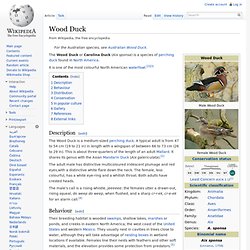
It is one of the most colourful North American waterfowl.[2][3] Description[edit] The Wood Duck is a medium-sized perching duck. A typical adult is from 47 to 54 cm (19 to 21 in) in length with a wingspan of between 66 to 73 cm (26 to 29 in). This is about three-quarters of the length of an adult Mallard. The adult male has distinctive multicoloured iridescent plumage and red eyes,with a distinctive white flare down the neck. Ringed Teal. The Ringed Teal (Callonetta leucophrys) is a small duck of South American forests.
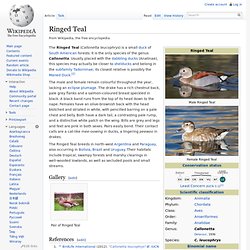
It is the only species of the genus Callonetta. Usually placed with the dabbling ducks (Anatinae), this species may actually be closer to shelducks and belong in the subfamily Tadorninae; its closest relative is possibly the Maned Duck.[2] The male and female remain colourful throughout the year, lacking an eclipse plumage. The drake has a rich chestnut back, pale grey flanks and a salmon-coloured breast speckled in black.
A black band runs from the top of its head down to the nape. The Ringed Teal breeds in north-west Argentina and Paraguay, also occurring in Bolivia, Brazil and Uruguay. Gallery[edit] References[edit] External links[edit] Ringed Teal. Mallard. The Mallard (/ˈmælɑrd/ or /ˈmælərd/) or Wild Duck (Anas platyrhynchos) is a dabbling duck which breeds throughout the temperate and subtropical Americas, Europe, Asia, and North Africa, and has been introduced to New Zealand and Australia.
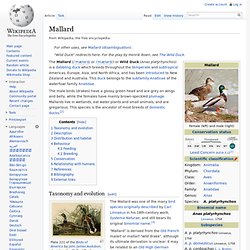
This duck belongs to the subfamily Anatinae of the waterfowl family Anatidae. The male birds (drakes) have a glossy green head and are grey on wings and belly, while the females have mainly brown-speckled plumage. Mallards live in wetlands, eat water plants and small animals, and are gregarious. This species is the ancestor of most breeds of domestic ducks.[2] Taxonomy and evolution[edit] The Mallard was one of the many bird species originally described by Carl Linnaeus in his 18th-century work, Systema Naturae, and still bears its original binomial name.[3] "Mallard" is derived from the Old French malart or mallart "wild drake", although its ultimate derivation is unclear.
The genome of Anas platyrhynchos was sequenced in 2013.[7] Red-crested Pochard. The Red-crested Pochard (Netta rufina) is a large diving duck.

Its breeding habitat is lowland marshes and lakes in southern Europe and Central Asia, wintering in the Indian Subcontinent and Africa. It is somewhat migratory, and northern birds winter further south into north Africa. The adult male is unmistakable. It has a rounded orange head, red bill and black breast. Mandarin Duck. The Mandarin Duck (Aix galericulata), or just Mandarin, is a medium-sized, East Asian perching duck, closely related to the North American Wood Duck.
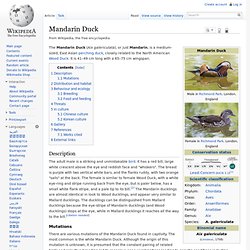
It is 41–49 cm long with a 65–75 cm wingspan. Description. Pacific Black Duck. The Pacific Black Duck (Anas superciliosa) is a dabbling duck found in much of Indonesia, New Guinea, Australia, New Zealand, and many islands in the southwestern Pacific, reaching to the Caroline Islands in the north and French Polynesia in the east.

It is usually called the Grey Duck in New Zealand, where it is also known by its Maori name, Pārera. Description[edit] Pacific Black Ducks - Durack Lakes - Palmerston - Northern Territory - Australia This sociable duck is found in a variety of wetland habitats, and its nesting habits are much like those of the Mallard, which is encroaching on its range in New Zealand.[2] It feeds by upending, like other Anas ducks. It has a dark body, and a paler head with a dark crown and facial stripes. There are three subspecies of Anas superciliosa: Wagga Wagga, New South Wales, Australia Various views and plumages[edit] A. s. rogersi showing green speculum, Sydney, NSW References[edit] Further reading[edit]
Bufflehead. Description[edit] The Bufflehead ranges from 32–40 cm (13–16 in) long and 270–550 g (9.5–19.4 oz), with the drakes larger than the females.

Averaging 35.5 cm (14.0 in) and 370 g (13 oz), it rivals the Green-winged Teal as the smallest American duck. Adult males are striking black and white, with iridescent green and purple heads with a large white patch behind the eye. Females are grey-toned with a smaller white patch behind the eye and a light underside.[3]